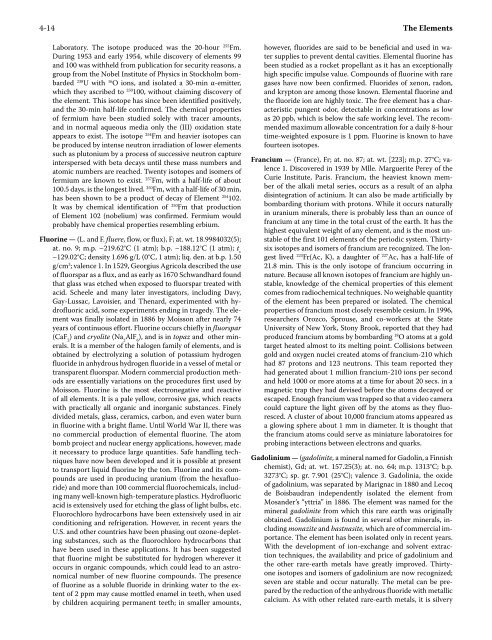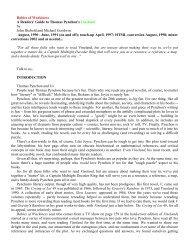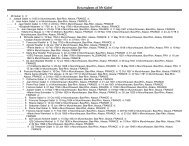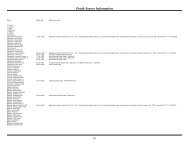CRC Handbook of Chemistry and Physics, 86th Edition
CRC Handbook of Chemistry and Physics, 86th Edition
CRC Handbook of Chemistry and Physics, 86th Edition
Create successful ePaper yourself
Turn your PDF publications into a flip-book with our unique Google optimized e-Paper software.
4-14 The Elements<br />
Laboratory. The isotope produced was the 20-hour 255 Fm.<br />
During 1953 <strong>and</strong> early 1954, while discovery <strong>of</strong> elements 99<br />
<strong>and</strong> 100 was withheld from publication for security reasons, a<br />
group from the Nobel Institute <strong>of</strong> <strong>Physics</strong> in Stockholm bombarded<br />
238 U with 16 O ions, <strong>and</strong> isolated a 30-min α-emitter,<br />
which they ascribed to 250 100, without claiming discovery <strong>of</strong><br />
the element. This isotope has since been identified positively,<br />
<strong>and</strong> the 30-min half-life confirmed. The chemical properties<br />
<strong>of</strong> fermium have been studied solely with tracer amounts,<br />
<strong>and</strong> in normal aqueous media only the (III) oxidation state<br />
appears to exist. The isotope 254 Fm <strong>and</strong> heavier isotopes can<br />
be produced by intense neutron irradiation <strong>of</strong> lower elements<br />
such as plutonium by a process <strong>of</strong> successive neutron capture<br />
interspersed with beta decays until these mass numbers <strong>and</strong><br />
atomic numbers are reached. Twenty isotopes <strong>and</strong> isomers <strong>of</strong><br />
fermium are known to exist. 257 Fm, with a half-life <strong>of</strong> about<br />
100.5 days, is the longest lived. 250 Fm, with a half-life <strong>of</strong> 30 min,<br />
has been shown to be a product <strong>of</strong> decay <strong>of</strong> Element 254 102.<br />
It was by chemical identification <strong>of</strong> 250 Fm that production<br />
<strong>of</strong> Element 102 (nobelium) was confirmed. Fermium would<br />
probably have chemical properties resembling erbium.<br />
Fluorine — (L. <strong>and</strong> F. fluere, flow, or flux), F; at. wt. 18.9984032(5);<br />
at. no. 9; m.p. –219.62°C (1 atm); b.p. –188.12°C (1 atm); t c<br />
–129.02°C; density 1.696 g/L (0°C, 1 atm); liq. den. at b.p. 1.50<br />
g/cm 3 ; valence 1. In 1529, Georgius Agricola described the use<br />
<strong>of</strong> fluorspar as a flux, <strong>and</strong> as early as 1670 Schw<strong>and</strong>hard found<br />
that glass was etched when exposed to fluorspar treated with<br />
acid. Scheele <strong>and</strong> many later investigators, including Davy,<br />
Gay-Lussac, Lavoisier, <strong>and</strong> Thenard, experimented with hydr<strong>of</strong>luoric<br />
acid, some experiments ending in tragedy. The element<br />
was finally isolated in 1886 by Moisson after nearly 74<br />
years <strong>of</strong> continuous effort. Fluorine occurs chiefly in fluorspar<br />
(CaF 2 ) <strong>and</strong> cryolite (Na 2 AlF 6 ), <strong>and</strong> is in topaz <strong>and</strong> other minerals.<br />
It is a member <strong>of</strong> the halogen family <strong>of</strong> elements, <strong>and</strong> is<br />
obtained by electrolyzing a solution <strong>of</strong> potassium hydrogen<br />
fluoride in anhydrous hydrogen fluoride in a vessel <strong>of</strong> metal or<br />
transparent fluorspar. Modern commercial production methods<br />
are essentially variations on the procedures first used by<br />
Moisson. Fluorine is the most electronegative <strong>and</strong> reactive<br />
<strong>of</strong> all elements. It is a pale yellow, corrosive gas, which reacts<br />
with practically all organic <strong>and</strong> inorganic substances. Finely<br />
divided metals, glass, ceramics, carbon, <strong>and</strong> even water burn<br />
in fluorine with a bright flame. Until World War II, there was<br />
no commercial production <strong>of</strong> elemental fluorine. The atom<br />
bomb project <strong>and</strong> nuclear energy applications, however, made<br />
it necessary to produce large quantities. Safe h<strong>and</strong>ling techniques<br />
have now been developed <strong>and</strong> it is possible at present<br />
to transport liquid fluorine by the ton. Fluorine <strong>and</strong> its compounds<br />
are used in producing uranium (from the hexafluoride)<br />
<strong>and</strong> more than 100 commercial fluorochemicals, including<br />
many well-known high-temperature plastics. Hydr<strong>of</strong>luoric<br />
acid is extensively used for etching the glass <strong>of</strong> light bulbs, etc.<br />
Fluorochloro hydrocarbons have been extensively used in air<br />
conditioning <strong>and</strong> refrigeration. However, in recent years the<br />
U.S. <strong>and</strong> other countries have been phasing out ozone-depleting<br />
substances, such as the fluorochloro hydrocarbons that<br />
have been used in these applications. It has been suggested<br />
that fluorine might be substituted for hydrogen wherever it<br />
occurs in organic compounds, which could lead to an astronomical<br />
number <strong>of</strong> new fluorine compounds. The presence<br />
<strong>of</strong> fluorine as a soluble fluoride in drinking water to the extent<br />
<strong>of</strong> 2 ppm may cause mottled enamel in teeth, when used<br />
by children acquiring permanent teeth; in smaller amounts,<br />
however, fluorides are said to be beneficial <strong>and</strong> used in water<br />
supplies to prevent dental cavities. Elemental fluorine has<br />
been studied as a rocket propellant as it has an exceptionally<br />
high specific impulse value. Compounds <strong>of</strong> fluorine with rare<br />
gases have now been confirmed. Fluorides <strong>of</strong> xenon, radon,<br />
<strong>and</strong> krypton are among those known. Elemental fluorine <strong>and</strong><br />
the fluoride ion are highly toxic. The free element has a characteristic<br />
pungent odor, detectable in concentrations as low<br />
as 20 ppb, which is below the safe working level. The recommended<br />
maximum allowable concentration for a daily 8-hour<br />
time-weighted exposure is 1 ppm. Fluorine is known to have<br />
fourteen isotopes.<br />
Francium — (France), Fr; at. no. 87; at. wt. [223]; m.p. 27°C; valence<br />
1. Discovered in 1939 by Mlle. Marguerite Perey <strong>of</strong> the<br />
Curie Institute, Paris. Francium, the heaviest known member<br />
<strong>of</strong> the alkali metal series, occurs as a result <strong>of</strong> an alpha<br />
disintegration <strong>of</strong> actinium. It can also be made artificially by<br />
bombarding thorium with protons. While it occurs naturally<br />
in uranium minerals, there is probably less than an ounce <strong>of</strong><br />
francium at any time in the total crust <strong>of</strong> the earth. It has the<br />
highest equivalent weight <strong>of</strong> any element, <strong>and</strong> is the most unstable<br />
<strong>of</strong> the first 101 elements <strong>of</strong> the periodic system. Thirtysix<br />
isotopes <strong>and</strong> isomers <strong>of</strong> francium are recognized. The longest<br />
lived 223 Fr(Ac, K), a daughter <strong>of</strong> 227 Ac, has a half-life <strong>of</strong><br />
21.8 min. This is the only isotope <strong>of</strong> francium occurring in<br />
nature. Because all known isotopes <strong>of</strong> francium are highly unstable,<br />
knowledge <strong>of</strong> the chemical properties <strong>of</strong> this element<br />
comes from radiochemical techniques. No weighable quantity<br />
<strong>of</strong> the element has been prepared or isolated. The chemical<br />
properties <strong>of</strong> francium most closely resemble cesium. In 1996,<br />
researchers Orozco, Sprouse, <strong>and</strong> co-workers at the State<br />
University <strong>of</strong> New York, Stony Brook, reported that they had<br />
produced francium atoms by bombarding 18 O atoms at a gold<br />
target heated almost to its melting point. Collisions between<br />
gold <strong>and</strong> oxygen nuclei created atoms <strong>of</strong> francium-210 which<br />
had 87 protons <strong>and</strong> 123 neutrons. This team reported they<br />
had generated about 1 million francium-210 ions per second<br />
<strong>and</strong> held 1000 or more atoms at a time for about 20 secs. in a<br />
magnetic trap they had devised before the atoms decayed or<br />
escaped. Enough francium was trapped so that a video camera<br />
could capture the light given <strong>of</strong>f by the atoms as they fluoresced.<br />
A cluster <strong>of</strong> about 10,000 francium atoms appeared as<br />
a glowing sphere about 1 mm in diameter. It is thought that<br />
the francium atoms could serve as miniature laboratoires for<br />
probing interactions between electrons <strong>and</strong> quarks.<br />
Gadolinium — (gadolinite, a mineral named for Gadolin, a Finnish<br />
chemist), Gd; at. wt. 157.25(3); at. no. 64; m.p. 1313°C; b.p.<br />
3273°C; sp. gr. 7.901 (25°C); valence 3. Gadolinia, the oxide<br />
<strong>of</strong> gadolinium, was separated by Marignac in 1880 <strong>and</strong> Lecoq<br />
de Boisbaudran independently isolated the element from<br />
Mos<strong>and</strong>er’s “yttria” in 1886. The element was named for the<br />
mineral gadolinite from which this rare earth was originally<br />
obtained. Gadolinium is found in several other minerals, including<br />
monazite <strong>and</strong> bastnasite, which are <strong>of</strong> commercial importance.<br />
The element has been isolated only in recent years.<br />
With the development <strong>of</strong> ion-exchange <strong>and</strong> solvent extraction<br />
techniques, the availability <strong>and</strong> price <strong>of</strong> gadolinium <strong>and</strong><br />
the other rare-earth metals have greatly improved. Thirtyone<br />
isotopes <strong>and</strong> isomers <strong>of</strong> gadolinium are now recognized;<br />
seven are stable <strong>and</strong> occur naturally. The metal can be prepared<br />
by the reduction <strong>of</strong> the anhydrous fluoride with metallic<br />
calcium. As with other related rare-earth metals, it is silvery







